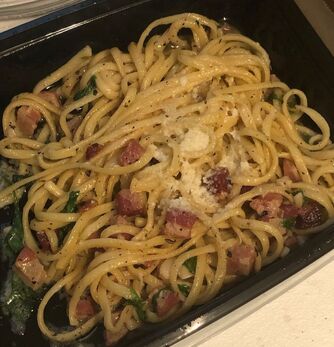|
Making sushi in your own home can be a daunting process. There are many steps in making sushi that require attention to detail, cutlery skills, planning, and timing appropriately. However, this series of articles is designed to teach anyone how to create a homemade sushi meal for friends and family. Planning is Critical to Success The most important lesson I have learned making sushi is how critical planning is to the overall success. The entire process can take three to four hours to complete a sushi roll platter for six individuals. It is important to understand the timeline and order of operations. Even planning what kind of rolls you want to make and how much rice to cook is important. Before I get into too many details, there is a critical step at the beginning of the process. The first step to making great sushi is purchasing the correct ingredients. What to Buy and Where to Find It
The basic ingredients for making sushi are typically available at your local grocery store. These items consist of seasoned rice vinegar, soy sauce, short-grain rice, soy sauce, and seaweed sheets. You can make your own seasoned rice vinegar at home, but I find it easier to purchase in a bottle. It is very important you purchase the correct kind of rice. Short-grain rice is ideal, but medium-grain will work as well. I always buy the same brand to avoid this issue. For seaweed sheets, I generally use one sheet per roll. If you want to make hand rolls, you will cut a sheet into smaller pieces. Two packs of ten sheets is usually enough. I have seen these ingredients for sale at grocery stores such as Harris Teeter, Kroger, and Bi-Lo. If you are fortunate enough to have a local oriental market, I recommend going there to purchase the necessary ingredients. From my experience, oriental markets offer more selection and lower prices than large grocery stores. Here is a list of the basic ingredients and my favorite brands: Seasoned Rice Vinegar - Kikkoman. Soy Sauce - Kikkoman's reduced salt version. Short-grain Rice - Kokuho Rose's 5 lb. bag of California rice. Wasabi Paste - Any brand that has wasabi paste pre-made in a tube. Seaweed Sheets - Any brand with normal sized sheets. Pickled Ginger: Harder to find at large supermarkets. Siracha Mayo (optional): Lee Kum Kee. You can make your own mixture too. Beyond buying the basic ingredients, you need to consider what kind of fillings to put inside your sushi rolls. The staple fillings I always consider buying are imitation crab, cooked shrimp, smoked salmon, cucumbers, cream cheese, and avocados. This will allow you to create California Rolls (imitation crab, cucumber, avocado), Philadelphia Rolls (smoked salmon and cream cheese), and other combinations with cooked seafood. If you are planning to purchase sashimi grade tuna or salmon, I highly recommend visiting a fresh seafood market. I suggest a combined total of 1.5 to 2.0 pounds of sashimi grade tuna and salmon from a seafood market for six individuals, in addition to other filling ingredients. To view the more blog posts in this multi-part series on making sushi at home, click the links below: For any home project, you need the right tools for a specific job. Making sushi at home is not much different. It is important to have the appropriate tools for creating beautiful sushi rolls. This article will cover the supplies required for making sushi rolls at home. Essential Tools You May Already Own Some of the required instruments for making sushi may already be in your kitchen. If you own any large wooden bowls or utensils, then you are one step in the right direction. Sushi rice gets very sticky after adding rice vinegar to it. The rice is less likely to stick to wood-made products than other materials. I highly recommend using a large wooden bowl and wooden spatula or rice paddle for cooling and seasoning sushi rice. A wooden spoon can be used instead of a spatula, but it is not preferable for spreading rice on a seaweed sheet. Another common tool required for making sushi is a sharp knife. You need a sharp knife to cut rolls, pieces of fish, and other fillings. You will need a large bowl with water and a splash of seasoned rice vinegar to wash the knife periodically. Any kitchen bowl will work as long as the blade of the knife can be submerged. Essential Tools to Buy The worst thing that can happen to sushi rice is burning it while cooking. Any burnt rice is not edible. To help avoid this issue, I recommend using an electric rice cooker or Instant Pot. These machines will cook the rice perfectly. If I had to purchase one, I would buy the Instant Pot due to its versatility. While you can cook the rice in a pot on the stove, I would avoid this method. Another essential tool for making sushi is a bamboo mat. This tool is used to create sushi rolls. I recommend buying two of them so another person can help roll. These are inexpensive items available at an oriental market or in a sushi essentials kit. Inexpensive Sushi Kits to Buy
I recommend purchasing an inexpensive sushi making kit. There are many kits available at multiple price points. Amazon.com has a few affordable kits that have everything you need to get started. You can buy items individually, but I believe the following sushi kit is a great value for around $10: Delamu Sushi Making Kit - comes with two bamboo mats, rice paddle, rice spreader, and five pairs of chopsticks. This one also comes with a link to a Beginner's Guide PDF document. The Essential Tools List Here is a quick reference list of the tools highlighted:
To view the more blog posts in this multi-part series on making sushi at home, click the links below: Capishe Real Italian Kitchen is a fast-casual Italian restaurant with two locations in Charlotte, North Carolina. Both establishments in Dilworth and SouthPark are open daily from 11 a.m. to 8 p.m. for dine-in and takeout. Charlotte Business Journal recognized Capishe as one of Charlotte’s best new restaurants of 2019 per Yelp. The menu for Capishe focuses on pizzas, pasta, sandwiches, and other small plates. There are multiple pizza offerings with red sauce (Rosso) and white sauce (Bianca). As for red pizzas, Ashley and I have tried the Prosciutto and San Lorenzo and enjoy them both. If there is an indecisive decision, flip a coin. Mozzone is our favorite white pizza with buffalo mozzarella, artichokes, Italian sausage, and other ingredients. Our second favorite white pizza is the Angelina, featuring truffle oil and vegetarian toppings. The 10-inch size pizza is enough food for one person. Even though Capishe is a fast-casual style restaurant, they make their pasta in-house. The rigatoni and linguine pasta dishes offer multiple combinations of the ingredients found in the pizzas. Ashley’s favorite is the Linguine Carbonara featuring pancetta, white wine, pecorino, and spices. While Ashley and I have not tried the sandwiches, we did enjoy the Antipasto. The salad is a generous portion of mixed greens, olives, prosciutto, and cheeses. Ordering curbside takeout is a smooth process from their website. Just select the location of choice and add food options to the cart. Once the order is processed, customers receive a pickup time. An employee greets customers and carries out orders to cars. Ashley and have done two takeout orders that were efficient and delicious. Capishe is a convenient and affordable option when craving pizza, pasta, and other Italian fares.
Lang Van is a Vietnamese restaurant that has been open for over 25 years. It is located near the corner of Shamrock Drive and Eastway Drive in Charlotte, North Carolina. Lang Van serves lunch and dinner every day except on Mondays when closed. Recently, Charlotteans came together and raised over $50,000 to support Lang Van. The owner, Dan Nguyen, was struggling to keep the restaurant afloat during the COVID-19 crisis. Why are residents donating money to help Lang Van? Amazing Food Lang Van offers over 130 dishes on their menu (prices not current). Customers are certain to find something to enjoy even with dietary restrictions or preferences. Pho and Hu Tieu, Vietnamese noodle soups, can be ordered with a variety of meats and seafood. For those interested in something besides soup, the vermicelli dishes are a great option. If a customer is overwhelmed by the menu, Nguyen is willing to assist. Lang Van receives positive reviews about the freshness and taste of their food on Trip Advisor. However, food is not the only thing that receives high praise at Lang Van. Amazing Service
Nguyen and her employees are focused on taking care of customers. They offer a high level of service to each person whether they choose dining inside or takeout. Nguyen makes every customer feel welcome and appreciated at Lang Van. This sentiment is echoed in a 2017 interview with Nguyen. The main priority for Lang Van's staff is always the customer. Nguyen decided to only allow takeout orders during COVID-19 for the safety of her staff and customers. Personal Experience During a recent visit, I tried the #43 Hu Tieu Hai San. It is a delectable seafood noodle soup and lighter alternative to Pho. I do enjoy Pho and typically order the #26 Pho Dac Biet from Lang Van. Also, the #2 Goi Cuon (Fresh Summer Rolls) is a nice appetizer to enjoy during warm weather. While waiting for a takeout order, I watched Nguyen greet multiple customers by name. She brought beers to a few customers while they waited to place an order. Nguyen and her staff made everyone feel welcomed and appreciated. The way Lang Van treats its customers, along with great food, makes it the best Vietnamese restaurant in Charlotte. Also, Lang Van is the highest-rated restaurant in Charlotte on Trip Advisor. I encourage anyone who enjoys Vietnamese cuisine or dining out to visit Lang Van. |
Follow me
on Instagram @card_knock_life Categories
All
Archives
July 2024
This website contains affiliate links
|












 RSS Feed
RSS Feed
